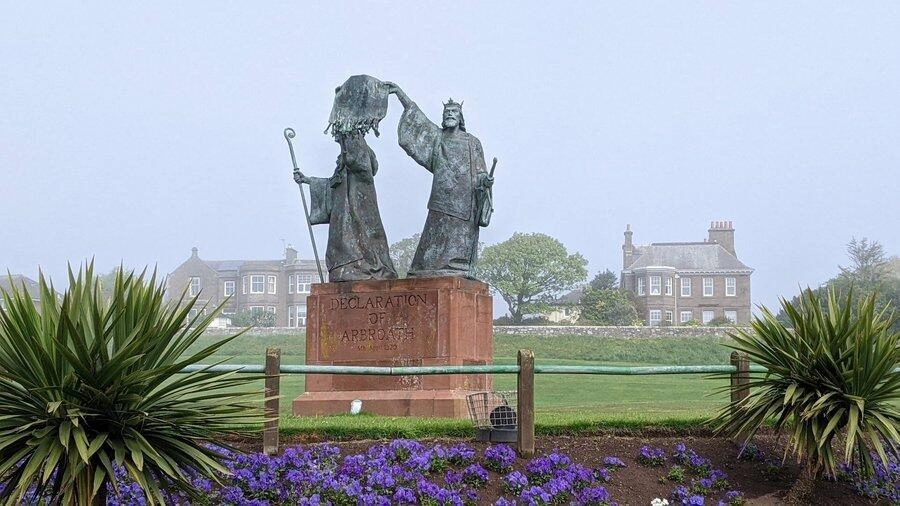Picture yourself in 1320, observing the Scottish nobles while they craft the Declaration of Arbroath, their fervent appeal for Scotland’s autonomy. This is not merely a historical manuscript; it is the pulsating core of a nation, the vibrant record of a people craving liberation. More than 700 years have passed since this proclamation was sanctioned by the Scottish barons, yet it still echoes in our contemporary dialogue about national identity and sovereignty. What makes this proclamation so vital in Scotland’s struggle for liberty? Let’s examine this together.
Origins of the Declaration
During the Wars of Independence in 1320, the Declaration of Arbroath took form, expressing Scotland’s quest for sovereignty. This potent manifesto artfully conveyed Scotland’s fight for liberty and its strong connection with the Church. An appeal directed towards Pope John XXII, the document was a call for recognition of Robert Bruce as the Scottish king.
The creation of the Declaration was not a casual affair. Every phrase of the 1,000-word testament mirrored Scotland’s struggle, emphasizing the complaints against Edward I, the English monarch whose rule brought only pain and carnage. The historical value of the Declaration lies in its vivid portrayal of Scotland’s aspirations for freedom and its resolved stance to protect its inherent rights.
This document symbolizes more than just an appeal; it represents Scotland’s unyielding quest for sovereignty. Its construction was meticulous and thoughtful, encapsulating the spirit of a nation’s conflict and desire for liberty. It offers a historical perspective that helps understand the strong bond between the Scottish people and the Church and their collective fight for sovereignty.
The Declaration of Arbroath, thus, exemplifies how words can ignite a revolution and motivate the quest for freedom.
Key Figures in Its Creation
Diving into the genesis of the Declaration of Arbroath, key individuals like Abbot Bernard of Arbroath and Alexander Kinninmonth are speculated to be the authors of this critical document. The ongoing debate about the authorship adds an exciting dimension to the historical backdrop, subtly indicating the intricate nature of the document’s creation.

Here’s a brief overview of the main contributors and events:
- Abbot Bernard of Arbroath, speculated to be an author
- Alexander Kinninmonth, also considered a possible author
- The composition of the Declaration during a Kings Council at Newbattle Abbey
- The Declaration’s place-date, ‘Arbroath 6 April 1320’
- The seals of significant earls and barons, distinguished by color
The identities of the signatories, from prominent earls to lesser barons, increase the political weight of the Declaration. Their seals, red wax for leading earls and green for lesser ones, reflect the pecking order within Scottish nobility. But, their unified stand for liberty is a reflection of the joint spirit of rebellion.
In your quest to comprehend Scotland’s struggle for liberty, keep these main contributors and their roles in mind. Their deeds have influenced the historical story, leaving an indelible mark on the enduring legacy of the Declaration of Arbroath.
Content and Interpretation
Continuing our journey, we will examine the content and interpretation of the Declaration of Arbroath, an impactful document symbolizing Scotland’s struggle for independence. It confirms Scotland’s autonomy from England, underscoring the divine entitlement of King Robert Bruce and the agreement of the Scottish populace. This important historical document encapsulates the ongoing battle for autonomy and liberty.

A study of its language showcases a unique Latin prose style and oratorical nature, transforming it into a compelling proclamation of Scottish nationality. It exceeds being a mere legal document, emerging as a literary marvel that carries significant cultural resonance, communicating directly to the spirit of every Scot.
The political consequences of the Declaration are significant. It argues that a king’s power is derived from the people’s will, a radical notion for that era. If a king were to violate this trust, the people had the right to select a successor, underlining the importance of accountability and consent.
The cultural impact of the Declaration reaches beyond its historical importance. It persists as a powerful emblem of the struggle for freedom and national identity, accentuating the principles of self-determination and liberty. Its words continue to inspire, keeping Scotland’s historical battle for freedom alive.
Impact on Scottish Nationalism
The Declaration of Arbroath has been a cornerstone in establishing Scottish nationalism and affirming Scotland’s independence from English rule. This crucial document had a profound influence in cultivating the Scottish identity and igniting the spirit of political defiance against any form of foreign control.

Here are five ways this important declaration has left a lasting imprint on Scottish nationalism:
- The declaration strongly affirmed Scotland’s independence, reinforcing the Scottish identity against English rule.
- It served as a representation of the collective desire of the Scottish people, strengthening their determination to resist foreign influence.
- The document underscored the ideas of self-determination and sovereignty, reminding the Scots of their inherent rights.
- The call for freedom and resistance to oppression echoed through generations of Scots, nurturing a feeling of national unity and pride.
- The enduring legacy of the document continues to motivate current nationalist movements, acting as a potent symbol of Scotland’s historical fight for freedom.
In essence, the Declaration of Arbroath did more than just assert Scotland’s independence—it also ignited a strong and enduring Scottish nationalism, a tribute to Scotland’s constant quest for freedom.
Influence on Global Declarations
The Declaration of Arbroath, originating in Scotland, has had a profound impact on global declarations. For instance, the American declaration of independence drew inspiration from the Arbroath’s strong proclamation of Scotland’s sovereignty in 1320. This not only holds historical value but also serves as a political guide for contemporary uses.

History shows a consistent pattern of nations striving for freedom. The Arbroath document signifies more than just Scottish freedom, it represents the universal human yearning for independence and sovereignty. The document emphasizes the strength of the people and the nation, demonstrating how the written word can alter the course of history.
The enduring relevance of the Declaration lies in its principles of people’s sovereignty, which form the cornerstone of Scottish identity and democracy. It is praised for representing Scotland’s historical existence, highlighting the struggle for rights, freedoms, and the democratic voice of the people.
The Declaration’s Legacy Today
The Declaration of Arbroath continues to stand as a potent symbol of Scotland’s historical independence and self-determination, shaping modern notions of freedom, sovereignty, and people’s power. Its significance in the present context is unquestionable as it shapes Scotland’s identity and democratic principles.
Interpretations of the Declaration in the present era include:
- A symbol of national pride: The declaration is not simply a document from the past; it represents Scotland’s persistent spirit.
- A cornerstone for democracy: The declaration’s tenets resonate with contemporary democratic ideals.
- A manual for liberty: Its expressions motivate those who aspire for freedom around the globe.
- A validation of people’s power: The declaration emphasizes the critical role of the people in governance.
- An observance of freedom of expression: The declaration serves as a reminder of our entitlement to express our opinions.
In short, the Declaration’s legacy is not a relic of the past. It is a living testament to Scotland’s struggle for liberty, and its influence is palpable today. The declaration exemplifies the efficacy of written proclamations in declaring independence, rights, and freedoms. Its persistent relevance serves as a guiding light for all who desire self-determination.

